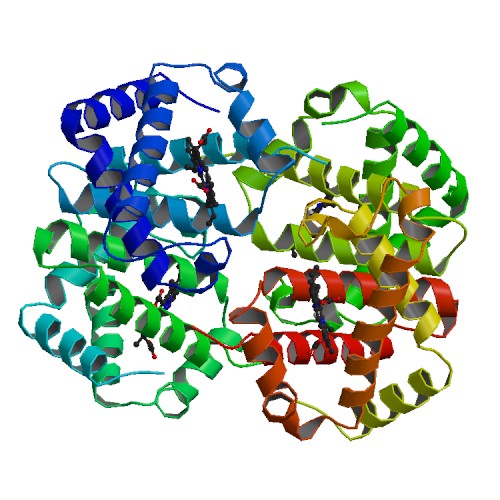Levels of Organization
Introduction to the Unit

What do you see when you look at this picture? Is it just a mass of tangled ribbons? Look closely. It is actually a complex pattern of three-dimensional shapes. It represents the structure of a common chemical found inside living cells. The chemical is a protein called hemoglobin. This protein in red blood cells transports oxygen around the body.
What are proteins? What other chemicals are found in living things? You will learn the answers to these questions as you read about biochemistry– the chemistry of life.
Life is a complex continuum of flows of energy and matter. Discrete structures such as organs and cells allow us to divide life into levels of organization. This organization is, to some extent, artificial and, to some extent, practical.
The human body is a complex, hierarchical system—that is, a system made up of smaller subsystems, which are themselves made up of even smaller systems. We commonly study these different hierarchical levels—levels of organization—separately. By breaking down the complex system into simpler parts, we can make the whole system easier to understand. This “reductionist” approach, reducing a complex system to simpler components, is central to how we practice modern science.
Therefore, we consider the body as a whole, then its subsystems, and then the components of these subsystems. We can model the organizational hierarchy within the body as comprised of organs, tissues, cells, cell organelles, macromolecules, molecules, and atoms.
The levels of organization that we will consider in this course are, from smallest to largest:
- The chemical level, which consists of atoms, ions, and small molecules
- The macromolecule level, which consists of large molecules
- The cell level, which consists of individual cells, is the smallest level that contains living entities
- The tissue level, which consists of groups of related cells working together to perform a specific function
- The organ level, which consists of groups of tissues working together to perform a higher-level function
- The organ system level, which includes all of the organs involved in performing a vital function
- The organism or whole-body level, which consists of a whole person
- The population or environment level, which involves the interactions of the person with their environment
Although we will consider each level individually, you must remember the connections between the levels. Processes and events at one level can affect other levels. An alteration in the structure of a protein (macromolecule level) can prevent a cell from functioning properly; this improper function can affect the tissues, organs, organ systems, and the whole body. And the reverse is true: changes to the body (organism level) can affect organs, tissues, cells, and molecules.
For example, suppose a single nitrogen-containing base in DNA (chemical level) is incorrect. This mutation causes an alteration in the structure of the beta-globin (β-globin) protein (macromolecule level), which is part of hemoglobin. The altered structure of β-globin causes the proteins to stick together and form fiber-like structures. Under certain physiological conditions, the fibers distort the shape of red blood cells (cell level), so the cells become curved and twisted. The abnormal cells get stuck in capillaries, reducing blood flow to tissues and organs (tissue and organ levels). Organ damage can result and permanently affect body function (whole-body level).
This example describes sickle cell anemia, a genetic blood disorder. We can clearly see the connections between levels of organization. A seemingly tiny error at the genetic (chemical) level causes significant changes in the body’s systems at higher levels. Many genetic diseases arise this way—through slight alterations in the genetic code.
But scientists are homing in on the genetic basis for some diseases, such as cancer. In some instances, our understanding may hint at genetic therapies for disease. Such technology is still largely experimental, but it shows the practical value of looking at the levels of organization of complex systems.
At every level of organization, structure is related to function. For example, water can perform many of its unique and life-sustaining properties because of its structure. It is a bent polar molecule that can form attractions with neighboring water molecules through hydrogen bonds. At the macromolecular level, the unique structures of enzymes allow these proteins to help speed up reactions. On the cell and tissue level, the rigid matrix structure of your bones enables them to support your body’s weight. At the organ level, the “J” shape of the stomach allows for partial segregation of its contents at the early stages of digestion.
